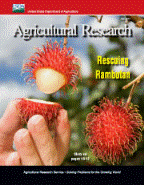United States Department of Agriculture: Agricultural Research Service, Lincoln, Nebraska

Agricultural Research Magazine
Date of this Version
4-2013
Document Type
Article
Citation
Agricultural Research April 2013
Abstract
Agricultural producers on the west side of California’s San Joaquin Valley (WSJV) used to drain irrigation wastewater into Kesterson Reservoir, a series of holding ponds that were part of the San Luis National Wildlife Refuge. But selenium levels in the water became hazardous to waterfowl, so the storage facility was closed in 1987. Since then, farmers have been keeping the wastewater—which also contains salt and traces of arsenic, boron, and molybdenum—in evaporation ponds on their own land, which takes around 10 percent of the crop land out of production.
Agricultural Research Service soil scientist Dennis Corwin and his colleagues had another idea. They thought it might be possible to use the spent wastewater for irrigating salt-tolerant forage grown on marginally productive saline and sodic soils. Sodic soils contain large quantities of sodium, which is one of the minerals found in salt compounds. Saline soils are contaminated with salt compounds at levels that significantly limit plant growth.
If this approach worked, farmers would have a viable alternative to simply storing the spent wastewater until it evaporated, and they would be able to reclaim degraded soils and produce livestock forage in the bargain. Irrigating with wastewater could also help stretch water supplies in a region already struggling with limitations imposed by intermittent droughts.
Included in
Agriculture Commons, Animal Sciences Commons, Food Science Commons, Plant Sciences Commons

